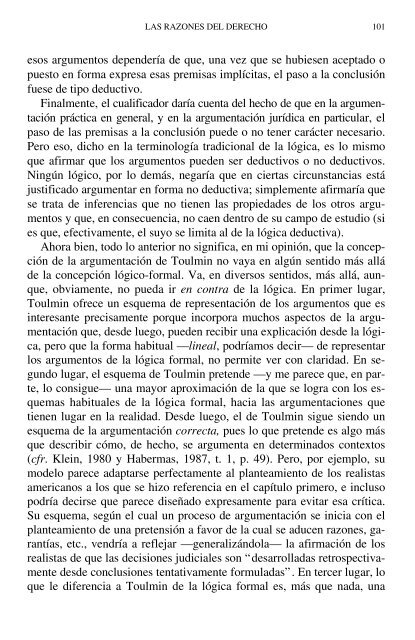LAS RAZONES DEL DERECHO Teo rías de la ar gu men ta ción ju rí di ca
You also want an ePaper? Increase the reach of your titles
YUMPU automatically turns print PDFs into web optimized ePapers that Google loves.
<strong>LAS</strong> <strong>RAZONES</strong> <strong>DEL</strong> <strong>DERECHO</strong> 101<br />
esos <strong>ar</strong><strong>gu</strong><strong>men</strong>tos <strong>de</strong>pen<strong>de</strong><strong>rí</strong>a <strong>de</strong> que, una vez que se hubiesen acep<strong>ta</strong>do o<br />
puesto en forma expresa esas premisas implíci<strong>ta</strong>s, el paso a <strong>la</strong> conclusión<br />
fuese <strong>de</strong> tipo <strong>de</strong>ductivo.<br />
Final<strong>men</strong>te, el cualifi<strong>ca</strong>dor d<strong>ar</strong>ía cuen<strong>ta</strong> <strong>de</strong>l hecho <strong>de</strong> que en <strong>la</strong> <strong>ar</strong><strong>gu</strong><strong>men</strong><strong>ta</strong><strong>ción</strong><br />
prácti<strong>ca</strong> en general, y en <strong>la</strong> <strong>ar</strong><strong>gu</strong><strong>men</strong><strong>ta</strong><strong>ción</strong> <strong>ju</strong><strong>rí</strong><strong>di</strong><strong>ca</strong> en p<strong>ar</strong>ticu<strong>la</strong>r, el<br />
paso <strong>de</strong> <strong>la</strong>s premisas a <strong>la</strong> conclusión pue<strong>de</strong> o no tener c<strong>ar</strong>ácter neces<strong>ar</strong>io.<br />
Pero eso, <strong>di</strong>cho en <strong>la</strong> terminología tra<strong>di</strong>cional <strong>de</strong> <strong>la</strong> lógi<strong>ca</strong>, es lo mismo<br />
que afirm<strong>ar</strong> que los <strong>ar</strong><strong>gu</strong><strong>men</strong>tos pue<strong>de</strong>n ser <strong>de</strong>ductivos o no <strong>de</strong>ductivos.<br />
Ningún lógico, por lo <strong>de</strong>más, neg<strong>ar</strong>ía que en cier<strong>ta</strong>s circuns<strong>ta</strong>ncias está<br />
<strong>ju</strong>stifi<strong>ca</strong>do <strong>ar</strong><strong>gu</strong><strong>men</strong>t<strong>ar</strong> en forma no <strong>de</strong>ductiva; simple<strong>men</strong>te afirm<strong>ar</strong>ía que<br />
se tra<strong>ta</strong> <strong>de</strong> inferencias que no tienen <strong>la</strong>s propieda<strong>de</strong>s <strong>de</strong> los otros <strong>ar</strong><strong>gu</strong><strong>men</strong>tos<br />
y que, en consecuencia, no <strong>ca</strong>en <strong>de</strong>ntro <strong>de</strong> su <strong>ca</strong>mpo <strong>de</strong> estu<strong>di</strong>o (si<br />
es que, efectiva<strong>men</strong>te, el suyo se limi<strong>ta</strong> al <strong>de</strong> <strong>la</strong> lógi<strong>ca</strong> <strong>de</strong>ductiva).<br />
Ahora bien, todo lo anterior no signifi<strong>ca</strong>, en mi opinión, que <strong>la</strong> concep<strong>ción</strong><br />
<strong>de</strong> <strong>la</strong> <strong>ar</strong><strong>gu</strong><strong>men</strong><strong>ta</strong><strong>ción</strong> <strong>de</strong> Toulmin no vaya en algún sentido más allá<br />
<strong>de</strong> <strong>la</strong> concep<strong>ción</strong> lógico-formal. Va, en <strong>di</strong>versos sentidos, más allá, aunque,<br />
obvia<strong>men</strong>te, no pueda ir en contra <strong>de</strong> <strong>la</strong> lógi<strong>ca</strong>. En primer lug<strong>ar</strong>,<br />
Toulmin ofrece un esquema <strong>de</strong> represen<strong>ta</strong><strong>ción</strong> <strong>de</strong> los <strong>ar</strong><strong>gu</strong><strong>men</strong>tos que es<br />
interesante precisa<strong>men</strong>te porque incorpora muchos aspectos <strong>de</strong> <strong>la</strong> <strong>ar</strong><strong>gu</strong><strong>men</strong><strong>ta</strong><strong>ción</strong><br />
que, <strong>de</strong>s<strong>de</strong> luego, pue<strong>de</strong>n recibir una expli<strong>ca</strong><strong>ción</strong> <strong>de</strong>s<strong>de</strong> <strong>la</strong> lógi<strong>ca</strong>,<br />
pero que <strong>la</strong> forma habitual —lineal, pod<strong>rí</strong>amos <strong>de</strong>cir— <strong>de</strong> represent<strong>ar</strong><br />
los <strong>ar</strong><strong>gu</strong><strong>men</strong>tos <strong>de</strong> <strong>la</strong> lógi<strong>ca</strong> formal, no permite ver con c<strong>la</strong>ridad. En se<strong>gu</strong>ndo<br />
lug<strong>ar</strong>, el esquema <strong>de</strong> Toulmin preten<strong>de</strong> —y me p<strong>ar</strong>ece que, en p<strong>ar</strong>te,<br />
lo consi<strong>gu</strong>e— una mayor aproxima<strong>ción</strong> <strong>de</strong> <strong>la</strong> que se logra con los esquemas<br />
habituales <strong>de</strong> <strong>la</strong> lógi<strong>ca</strong> formal, hacia <strong>la</strong>s <strong>ar</strong><strong>gu</strong><strong>men</strong><strong>ta</strong>ciones que<br />
tienen lug<strong>ar</strong> en <strong>la</strong> realidad. Des<strong>de</strong> luego, el <strong>de</strong> Toulmin si<strong>gu</strong>e siendo un<br />
esquema <strong>de</strong> <strong>la</strong> <strong>ar</strong><strong>gu</strong><strong>men</strong><strong>ta</strong><strong>ción</strong> correc<strong>ta</strong>, pues lo que preten<strong>de</strong> es algo más<br />
que <strong>de</strong>scribir cómo, <strong>de</strong> hecho, se <strong>ar</strong><strong>gu</strong><strong>men</strong><strong>ta</strong> en <strong>de</strong>terminados contextos<br />
(cfr. Klein, 1980 y Habermas, 1987, t. 1, p. 49). Pero, por ejemplo, su<br />
mo<strong>de</strong>lo p<strong>ar</strong>ece adapt<strong>ar</strong>se perfec<strong>ta</strong><strong>men</strong>te al p<strong>la</strong>nteamiento <strong>de</strong> los realis<strong>ta</strong>s<br />
ameri<strong>ca</strong>nos a los que se hizo referencia en el <strong>ca</strong>pítulo primero, e incluso<br />
pod<strong>rí</strong>a <strong>de</strong>cirse que p<strong>ar</strong>ece <strong>di</strong>señado expresa<strong>men</strong>te p<strong>ar</strong>a evit<strong>ar</strong> esa c<strong>rí</strong>ti<strong>ca</strong>.<br />
Su esquema, según el cual un proceso <strong>de</strong> <strong>ar</strong><strong>gu</strong><strong>men</strong><strong>ta</strong><strong>ción</strong> se inicia con el<br />
p<strong>la</strong>nteamiento <strong>de</strong> una pretensión a favor <strong>de</strong> <strong>la</strong> cual se aducen razones, g<strong>ar</strong>antías,<br />
etc., vend<strong>rí</strong>a a reflej<strong>ar</strong> —generalizándo<strong>la</strong>— <strong>la</strong> afirma<strong>ción</strong> <strong>de</strong> los<br />
realis<strong>ta</strong>s <strong>de</strong> que <strong>la</strong>s <strong>de</strong>cisiones <strong>ju</strong><strong>di</strong>ciales son “<strong>de</strong>s<strong>ar</strong>rol<strong>la</strong>das retrospectiva<strong>men</strong>te<br />
<strong>de</strong>s<strong>de</strong> conclusiones ten<strong>ta</strong>tiva<strong>men</strong>te formu<strong>la</strong>das”. En tercer lug<strong>ar</strong>, lo<br />
que le <strong>di</strong>ferencia a Toulmin <strong>de</strong> <strong>la</strong> lógi<strong>ca</strong> formal es, más que nada, una



